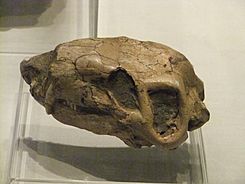Therocephalians facts for kids
Therocephalia (say: Thee-roh-seh-FAY-lee-uh) means 'beast-heads'. They were an ancient group of animals that are now extinct. These creatures lived a very long time ago, from about 265 million to 245 million years ago. They were part of a bigger group called theriodonts.
Quick facts for kids Therocephalia |
|
|---|---|
 |
|
| Skull of a therocephalian in the Wrexham Museum, Wales | |
| Scientific classification | |
| Kingdom: | |
| Class: | |
| Order: | |
| (unranked): | |
| Infraorder: |
Theriocephalia
|
Contents
What Were Therocephalians?
Therocephalians were a type of therapsid. Therapsids are sometimes called "mammal-like reptiles." This is because they had features of both reptiles and mammals.
Therocephalians are especially interesting because they were very closely related to cynodonts. Cynodonts were the group of animals that eventually evolved into mammals.
What Did They Look Like?
These animals were named "beast-heads" because of their large skulls. Their skulls and teeth show that they were good carnivores, meaning they ate meat.
Scientists think therocephalians might have had features like whiskers and even hair. This is another way they were similar to mammals.
Where Were Their Fossils Found?
Many therocephalian fossils have been found in the Karoo region of South Africa. But their remains have also been discovered in other parts of the world.
These places include Russia, China, and even Antarctica. This shows that they spread out across the globe a long time ago.
Their Journey Across the World
The earliest therocephalian fossils were found in South Africa. This suggests they first appeared in a supercontinent called Gondwana.
From there, they quickly spread to many different places. They became a successful group of animals for a while.
Surviving a Great Extinction
About 252 million years ago, a huge event happened called the Permian–Triassic extinction event. This was one of the biggest extinctions in Earth's history. Many types of animals died out.
Most therocephalians did not survive this event. However, a small group of them, called Eutherocephalia, managed to live on. They even continued to develop new types of animals in the early Triassic period.
Why Did They Disappear?
Even the last therocephalians eventually died out. This happened by the early middle Triassic period.
Scientists are not entirely sure why they became extinct. It remains a mystery why these "beast-heads" disappeared from Earth.
Images for kids
See also
 In Spanish: Therocephalia para niños
In Spanish: Therocephalia para niños





